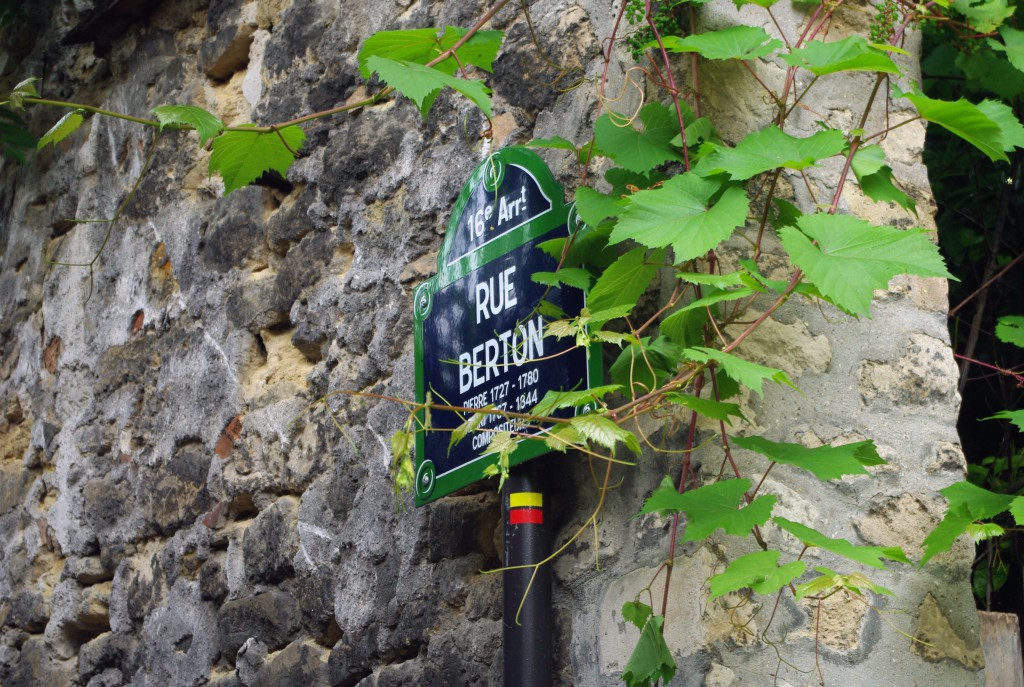There are a number of rural-looking streets to discover in Paris. One of them is rue Berton in Passy (16th arrondissement). Not far from the Eiffel Tower, the picturesque street is situated on the side of a hill. The rue Berton, with its lush vegetation, is reminiscent of the time when Passy was a winegrower village outside the limits of Paris.
Rue Berton: A bit of history
The street featured in the Paris map of Roussel in 1730. On 2 October 1865, it took its current name as a tribute to composers Pierre Monton Berton (1727-1780) and Henri Montan Berton (1767-1846).

In the past, the hillside of Passy was transformed into terraces. Country houses were built along with luxurious townhouses for the aristocracy. The rue Berton gives access to the last remains of the terraces of Passy dating back to the 16th century.

These terraces disappeared following the rapid urbanisation of Passy. The pace of growth of construction of housing increased from 1860 when the village was annexed to Paris. At first, the plots enjoyed a breathtaking view of the Seine. By the second half of the 20th century, buildings covered most of the Passy hillside.
The Auguste Perret building

We suggest you start the visit from the corner of rue Raynouard and avenue de Lamballe. To the left, the paved street is flanked by the rue Raynouard which is accessible by a long staircase.
The first building to the left was designed by architect Auguste Perret (1874-1954).
The reinforced concrete apartment block stands alone on the crest of the hill of Passy. Perret lived inside from 1933 until his death in 1954.
At the time of construction (1928-1930), it was the first concrete block. Perret is also famous for having designed the general plan for the reconstruction of Le Havre in the aftermath of World War Two.
The Balzac House

Further on, the street reaches a cul-de-sac for cars. At number 24 is the green gate leading to the Balzac House. This site has been occupied at least since the Middle Ages.
During the second half of the 18th century, the whole plot belonged to Jean de Julienne, director of the Gobelins manufacture.
French novelist Honoré de Balzac (1799-1850) lived there between 1840 and 1847. He wrote the Human Comedy and some of his famous masterpieces. The country house is now a museum dedicated to Balzac.

The Balzac Museum displays personal mementoes, pictures, engravings and objects related to his loved ones and contemporaries, as well as a large number of original publications, manuscripts and illustrations. There is a fine view of the country house and its garden from the rue Raynouard with the Eiffel Tower in the background.
Archaeological research in 2002 confirmed the presence of cellars that gave access to troglodyte houses. Dating from the Middle Ages, this example of housing seems quite unique in Paris. When walking along the rue Berton, always remember that the village of Passy was once inhabited by farmers, winemakers and quarrymen.
Limit between Auteuil and Passy
To the right of the green gate of number 24 is a plaque on the wall that reads:
Borne posée en 1731 pour indiquer la limite des seigneuries d’Auteuil et de Passy.
(Bollard erected in 1731 to indicate the boundary of the seigniories of Auteuil and Passy.)

The plaque refers to the stone milestone that was put there to signal the limit between the seigniories of Auteuil and Passy. Until 1860, Auteuil and Passy were villages outside the limits of Paris.
According to historians, the statement is wrong. As a matter of fact, the limit was located at the site of the Maison de Radio-France. Maybe the milestone was added there, to prevent access to the narrow lane of carriages.
Rue Berton: one of Paris’ narrowest streets
From the green gate of the Balzac House onwards, the rue Berton becomes a narrow lane. The width between the two ivy-covered walls never exceeds 1.50 m. This is one of Paris’ narrowest streets.

The paved lane is punctuated by former gas lamp posts. Imagine the old path that once ran from the banks of the River Seine up to the top of the Passy hillside through the vineyards.

Notice that wall bracket candelabra: they are very rare in Paris where lamps are usually fixed on straight posts.

The Hôtel de Lamballe
Rue Berton ends at the junction with rue d’Ankara and avenue Marcel Proust. There is located the entrance to the Embassy of Turkey.

The estate was formerly known as Hôtel de Lamballe. Dating from the 17th century, it was bought by the princess of Lamballe, a personal friend of Queen Marie-Antoinette.
The estate was turned into a private psychiatric hospital in 1846. Doctor Blanche treated a few French celebrities such as the poet Gérard de Nerval and the writer Guy de Maupassant.
The townhouse is not visible from the rue Berton but can be seen from the rue Raynouard.
How to get to Rue Berton
Location of the Rue Berton (link opens a google map): http://goo.gl/maps/4AfxFB4fa2U2
Closest métro stations: Passy (line 6), Av. du Président Kennedy Maison de Radio-France (RER C).





[…] Rue Berton, Paris […]